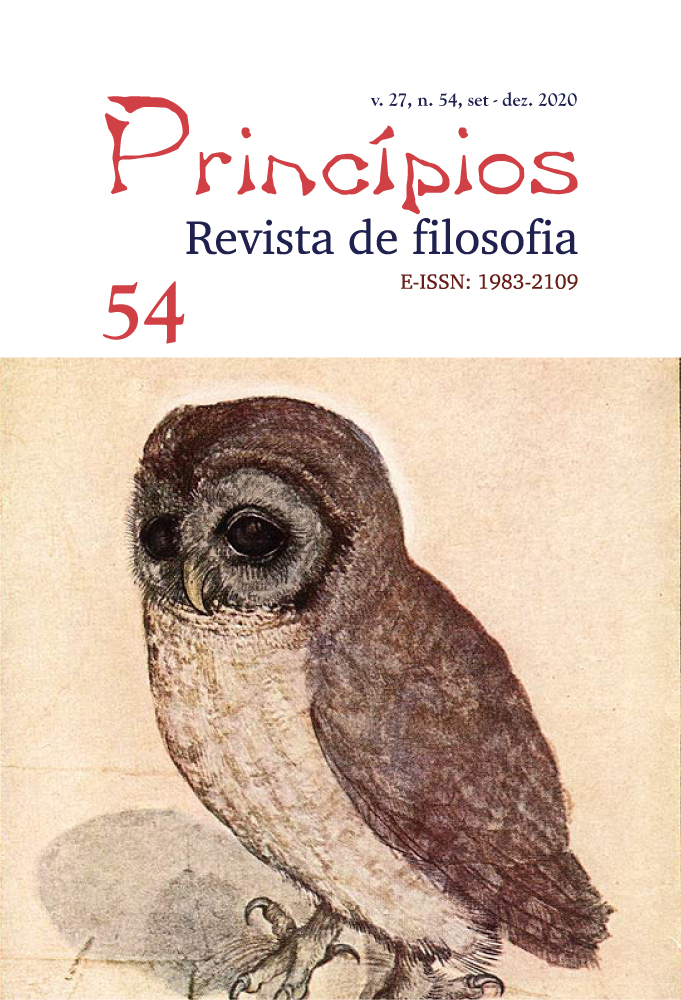¿Qué es, si es que es algo, una raza humana?
DOI:
https://doi.org/10.21680/1983-2109.2020v27n54ID20851Palavras-chave:
Acción afirmativa, Clase natural, Linaje, Razas, Tipos FisonómicosResumo
No hay ningún concepto de raza que, al aplicarse al Homo sapiens, encuentre su extensión en un grupo de linajes evolutivamente diferenciables. Consecuentemente, desde un punto de vista filogenético, las razas humanas son una ficción. Sin embargo, las ‘razas humanas’ pueden llegar a funcionar como predicados con algún grado de relevancia epistémica. Esos ‘predicados raciales’ especificarían ciertos tipos fisonómicos, de extensión relativamente delimitable, y con algún contenido disposicional, que pueden ser significativos en distintos contextos de discusión. Muy particularmente, cuando se trata identificar a grupos, e individuos, que puedan encontrarse en condiciones de vulnerabilidad, o que puedan venir a ser beneficiarios de políticas de acción afirmativa.
Downloads
Referências
ADAMS, B. Forensic Anthropology. New York: Infobase publishing, 2007.
ANDREASEN, R. The meaning of ‘race’: folk conceptions and the new Biology of race. Journal of Philosophy, v.102, 2005, p. 94-106.
ANDREASEN, R. A new perspective on the race debate. In: SOBER, E. (Ed.). Conceptual issues in Evolutionary Biology. Cambridge: MIT Press, 2006. p. 477-501.
BIONDI, G. & RICKARDS, O. The scientific fallacy of the human biological concept of race. Mankind, v.42, 2002, p. 355-388.
CABRERA, M. Malaria y hemoglobina S: ¿resistencia o protección? Medisur, v.16, 2018, p. 504-510.
CAPONI, G. Las especies son linajes de poblaciones microevolutivamente interconectadas: una mejor delimitación del concepto evolucionario de especie. Principia, v.17, 2013, p. 3995-418.
CAPONI, G. Lineages and systems: a conceptual discontinuity in biological hierarchies. In: ELDREDGE, Niles; PIEVANI, Telmo; SERRELLI, Emanuele; TËMKIN, Ilya (eds.): Evolutionary theory: a hierarchical perspective. Chicago: Chicago University Press, 2016, p. 47-62.
CAPONI, G. Los taxones tampoco son racimos homeostáticos de propiedades. Disputatio, v.6, 2017, p. 323-356.
CAPONI, G. Lo natural, lo seglar y lo sobrenatural. Revista de Humanidades de Valparaíso, v.14, 2018a, p. 27-55.
CAPONI, G. Esencia e identidad en Filosofía de la Taxonomía. Culturas Científicas, v.1, 2018b, p. 1-15.
CARTMILL, M. The status of the race concept in Physical Anthropology. American Anthropologist, v.100, 1998, p. 651-660.
CONAN DOYLE, A. The red-headed league (from The adventures of Sherlock Holmes [1891]). In: CONAN DOYLE, A. Sherlock Homes: the complete facsimile edition. Hertfordshire: Wordsworth, 1989, p. 132-146.
COYNE, J. & ORR, A. Speciation. Sunderland: Sinauer, 2004.
DARWIN, C. On the origin of species. London: Murray, 1859.
DE QUEIROZ, K. Branches in the lines of descent: Charles Darwin and the evolution of the species concept. Biological Journal of the Linnean Society, v.103, 2011, p. 19-35.
DOBZHANSKY, T. Genetics and the origin of species. New York: Columbia University Press, 1951.
DUPRÉ, J. El legado de Darwin. Buenos Aires: Katz, 2006.
ELDREDGE, N. Unfinished synthesis. Oxford: Oxford University Press, 1985.
ELDREDGE, N. Reinventing Darwin. London: Phoenix, 1996.
ELDREDGE, N. The checkered career of hierarchical thinking in Evolutionary Biology. In: ELDREDGE, N.; PIEVANI, T.; SERRELLI, E.; TËMKIN, I. (Ed.): Evolutionary theory: a hierarchical perspective. Chicago: Chicago University Press, 2016, p. 1-16.
ELDREDGE, N. & CRACRAFT, B. Phylogenetic patterns and the evolutionary process. New York: Columbia University Press, 1980.
ERESHEFSKY, M. Species, taxonomy, and Systematics. In: MAUTHEN, M. & STEPHENS, C. (Ed.). Philosophy of Biology. Amsterdam: Elsevier, 2007, p. 403-428.
ERESHEFSKY, M. Systematics and Taxonomy. In: SARKAR, S. & PLUTYNSKI, A. (Ed). Companion to the Philosophy of Biology. Oxford: Blackwell, 2008, p. 99-118.
FREIRE-MAIA, N. De Darwin à Teoria Sintética. Belo Horizonte: Itatiaia, 1988.
FUTUYMA, D. Evolution. London: Sinauer, 2005.
GOODMAN, N. Fact, fiction, and forecast. Indianapolis: Bob-Merril, 1965.
GOULD, S. ¿Qué es, si es que es algo, una cebra? In: GOULD, S. Dientes de gallina y dedos de caballo. Madrid: Blume, 1984, p. 377-388.
GOULD, S. La falsa medida del hombre. Buenos Aires: Orbis, 1988.
GOULD, S. La igualdad humana es un hecho contingente de la historia. In: GOULD, S. La sonrisa del flamenco. Barcelona: Crítica, 1995, p. 157-168.
GRAVEL, R.; TRIGGS-RAINE, B.; MAHURAN, D. Biochemistry and genetics of Tay-Sachs Disease. Le journal canadien des sciences neurologiques, v.18, 1991, p. 419S-423S.
HACKING, I. Why race stills maters. Daedalus, v.134, 2005, p. 102-116.
HENNIG, W. Elementos de Sistemática Filogenética. Buenos Aires: Eudeba, 1968.
HERRSTEIN, R. & MURRAY, C. The bell curve. New York, Free Press, 1994.
HOCHMAN, A. Racial discrimination: how not to do it. Studies in History & Philosophy of Biological and Biomedical Sciences, v.44, 2013, p. 278-286.
INTERNATIONAL COMMISSION OF ZOOLOGICAL NOMENCLATURE. Code International de Nomenclature Zoologique. London: The International Commission of Zoological Nomenclature, 1999.
KATTMANN, U. Race, genes and culture. In: KOEGELER, M. & PARNCUTT, R. (Ed.): Interculturality. New Castle: Cambridge Scholar Publishing, 2013, p. 130-184.
KITCHER, P. Does ‘race’ have a future? Philosophy & public affairs, v.35, 2007, p. 293-317.
LE GUYADER, H. Classification et évolution. Paris: Le Pommier, 2003.
LEWONTIN, R.; ROSE, S.; KAMIN, L. No está en los genes: racismo, genética e ideología. Barcelona: Crítica, 2003.
LINCOLN, R.; BOXSHALL, G.; CLARCK, P. Diccionario de Ecología, Evolución y Taxonomía. México: Fondo de Cultura Económica, 2009.
LIPKO, P. & DI PASQUO, F. De cómo la Biología asume la existencia de razas en el Siglo XX. Scientiae Studia, v.6, 2008, p. 219-233.
LLORENTE, J. La búsqueda del método natural. México: Fondo de Cultura Económica, 1998.
LÓPEZ BELTRÁN, C. Escenarios de la patologización racial: la anomalía amerindia en una nación enferma. Metatheoria, v.8, 2018, p. 181-193.
MacEACHERN, S. The concept of race in contemporary Anthropology. In: SCUPIN, R. (Ed.). Race and ethnicity. New York: Prentice-Hall, 2011, p. 34-57.
MAGNOLI, D. Uma gota de sangue. São Paulo: Contexto, 2009.
MAI, L.; OWL, M.; KERSTING, P. The Cambridge Dictionary of Human Biology and Evolution. Cambridge: Cambridge University Press, 2005.
MAIO, M. & SANTOS, R. Política de cotas raciais, os ‘olhos da sociedade’ e os usos da Antropologia: o caso do vestibular da Universidade de Brasília. Horizontes Antropológicos, v.11, 2005a, p. 181-214.
MAIO, M. & SANTOS, R. As cotas raciais nos horizontes da Antropologia. Horizontes Antropológicos, v.11, 2005b, p. 292-308.
MAYDEN, R. On biological species, species concepts and individuals in the nature world. Fish & Fisheries, v.3, 2002, p. 171-196.
MAYR, E. Systematics and the origin of species. Cambridge: Harvard University Press, 1942.
MAYR, E. Animal species and evolution. Cambridge: Harvard University Press, 1963.
MAYR, E. Así es la Biología. Madrid: Debate, 1998.
MAYR, E. Species concepts and their application [1963]. In: RUSE, M. (Ed.). Philosophy of Biology. Amherst: Prometheus, 2007: p. 203-213
MAYR, E. The Biological Species Concept. In: WHEELER, Q. & MEIER, R. (Ed.). Species concepts and Phylogenetic Theory. New York: Columbia University Press. 2000, p. 17-29.
MILL, J. A System of Logic. Toronto: University of Toronto, 1974[1843].
OUSLEY, S.; JANTS, R.; FREID, D. Understanding race and human variation: why forensic anthropologist are good at identifying race. American Journal of Physical Anthropology, v.139, 2009, p. 68-76.
PARRA, E. Evolución de la pigmentación en la especie humana. Piel, v.26, 2011, p. 66-79.
PARRA, F.; AMADO, R.; LAMBERTUCCI, J.; ROCHA, J.; ANTUNES, C.; PENA, S. Color and genomic ancestry in Brazilians. Proceedings of the National Academy of Science, v.100, 2003, p. 177-182.
PENA, S. & BORTOLINI, M. Pode a Genética definir quem deve se beneficiar das cotas universitárias e demais ações afirmativas? Estudos Avançados, v.18, 2004, p. 31-50.
PIGLIUCCI, M. What are we to make on the concept of race? Studies in History & Philosophy of Biological and Biomedical Science, v.44, 2013, p. 272-277.
PIGLIUCCI, M. & KAPLAN, J. On the concept of biological race and its applicability to humans. Philosophy of Science, v.70, 2003, p. 1161-1172.
PUTZKE, J.; HICKEN, B.; RICHARDS, S. Race: predictor versus proxy variable? Archives of Physical Medicine and Rehabilitation, v.83, 2002, p. 1603-1611.
RICHARDS, R. Classification in Darwin’s origin. In: RUSE, M. & RICHARDS, R. (Ed.). The Cambridge Companion to the Origin of Species. Cambridge: Cambridge University Press, 2009, p. 173-193.
RICHARDS, R. Solving the species problem. In: RUSE, M. (Ed.). Philosophy of Biology. Amherst: Prometheus, 2007, p. 215-227.
RICHARDS, R. The species problem. Cambridge: Cambridge University Press, 2010.
ROSENBERG, N.; PRITCHARD, J.; WEBER, J.; CANN, H.; KIDD, K.; ZHIVOTOVSKY, L.; FELDMAN, M. Genetic structure of human population. Science 298, 2002, p. 2381-2385.
ROZEMBERG, R. & PEREIRA, L. The frequency of Tay-Sachs Disease in the Brazilian Jewish population justifies a carrier of screening program. São Paulo Medical Journal, v.119, 2001, p. 146-149.
SANTOS, R.; CALDAS, A.; BORGES, G.; VALENTE, J.; PORTELA, M.; MARINHO, G. Mortalidade infantil segundo cor ou raça com base no censo demográfico de 2010 e nos sistemas nacionais de informação em saúde no Brasil. Cadernos de Saúde Pública, v.33, 2017, e00046516.
SAUER, N. Forensic Anthropology and the concept of race. Social Science & Medicine, v.34, 1992, p. 107-111.
SESARDIC, N. Confusions about races. Biology & Philosophy, v.25, 2010, p. 143-162.
SIMPSON, G. The principles of classification and a classification of mammals. New York: American Museum of Natural History, 1945.
SIMPSON, G. The species concept. Evolution, v.5, 1951, p. 285-298.
SIMPSON, G. Principles of Animal Taxonomy. New York: Columbia University Press, 1961.
SPENCER, Q. A radical solution to the race problem. Philosophy of Science, v.81, 2014, p. 1025-1038.
STAMOS, D. Evolución. Barcelona: Buridán, 2008.
SOABI, M. Realism and artifact kinds. In: KROHS, U. & KROES, P. (Ed.). Functions in biological and artificial worlds. Cambridge: MIT Press, 2009, p. 185-202.
SUSSMAN, R. The myht of race. Cambridge: Harvard University Press, 2014.
TASSY, P. L’arbre à remonter le temps. Paris: Diderot, 1998.
TEMPLETON, A. Human races: a genetic and evolutionary perspective. American Anthropologist, v.100, 1998, p. 632-650.
TEMPLETON, A. Biological races in humans. Studies in History & Philosophy of Biological and Biomedical Sciences, v.44, 2013, p. 262-271.
TEMPLETON, A. La evolución y el concepto de raza humana. In: LOSOS, J. & LENSKI, R. (Ed.). Cómo la evolución configura nuestras vidas. Barcelona: Buridán, 2018, p. 447-466.
TORRETTI, R. La proliferación de los conceptos de especie en la Biología Evolucionista. Theoria, v.69, 2010, p. 325-377.
TRIGGS-RAINE, B.; FEIGENBAUM A.; NATOWICZ, M.; SKOMOROWSKI, M.; SCHUSTER, S.; CLARKE, J.; MAHURAN, D.; KOLODNY, E.; GRAVEL, R. 1 Screening for carriers of Tay-Sachs Disease among Ashkenazi Jews. The New England Journal of Medicine, v.323, 1990, p. 6-12.
TURESSON, G. The species and the variety as ecological units. Hereditas, v.3, 1922a, p. 100-113.
TURESSON, G. The genotypical response of the plant species to the habitat. Hereditas, v.3, 1922b, p. 211-350.
WADE, N. Una herencia incomoda. Barcelona: Ariel, 2015.
WILEY, E. Phylogenetics. New York: Wiley, 1981.
WILEY, E. & LIEBERMAN, B. Phylogenetics. Hoboken: Wiley & Blackwell, 2011.
WOOD, A. What, if anything, is a rabbit? Evolution, v.11, 1957, p. 417-425.
Downloads
Publicado
Como Citar
Edição
Seção
Licença
Autores mantêm os direitos autorais e concedem à revista o direito de primeira publicação, com o trabalho simultaneamente licenciado sob a Licença Creative Commons Attribution que permite o compartilhamento do trabalho com reconhecimento da autoria e publicação inicial nesta revista.
Termos da licença:
| Não Comercial (NC) | Os licenciados podem copiar, distribuir, exibir e executar a obra e fazer trabalhos derivados dela, desde que sejam para fins não comerciais. |
| Compartilha Igual (SA) | Os licenciados devem distribuir obras derivadas somente sob uma licença idêntica à que governa a obra original ou menos restritiva. |


 Português (Brasil)
Português (Brasil) English
English Español (España)
Español (España) Français (Canada)
Français (Canada)


